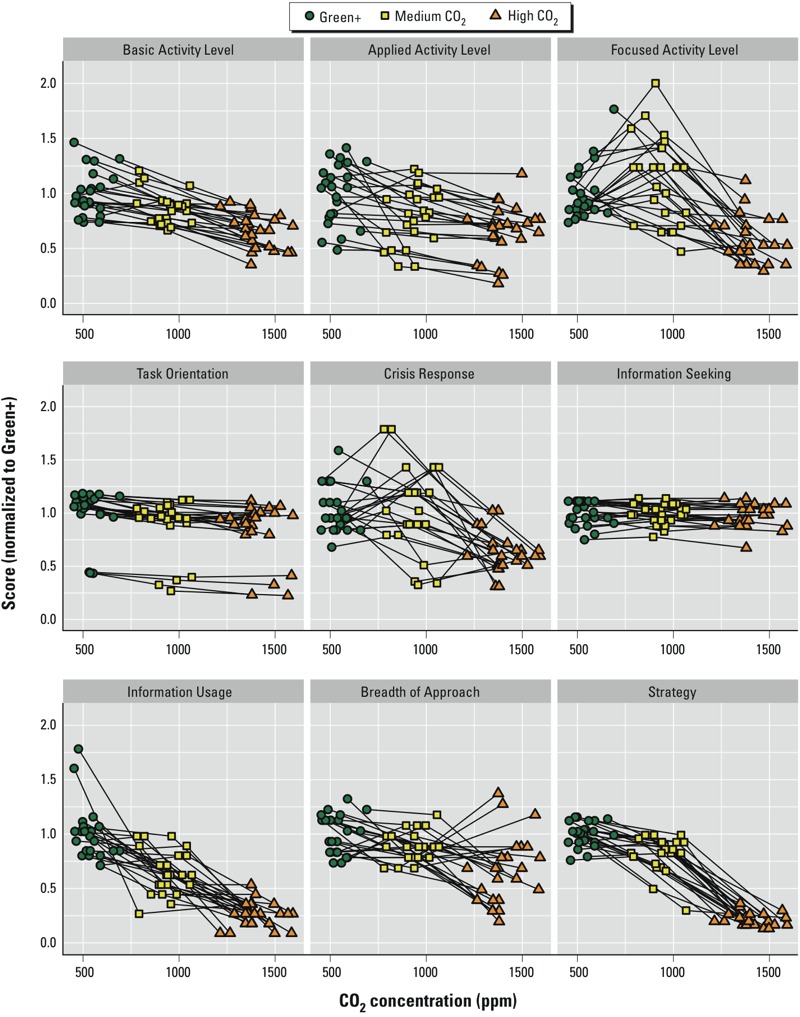Monitoring CO2 Levels in Indoor Spaces
Typical outdoor carbon dioxide concentrations hover between 300-400 ppm. In urban areas, outdooor concentrations hit 600-900 ppm USDA fact sheet. But, most people including me spend most of our time indoors.
What is the CO2 level like indoors? At the School of Forestry at Yale, I noticed a CO2 monitor in one of the classrooms. It read ~700 ppm in a large classroom with nobody else in it except me. In Boston, median CO2 levels were 809 ppm and 1204 ppm in conventional apartments and newly constructed LEED platinum apartments respectively (Colton et. al 2014). CO2 levels were >1000 ppm in 79 of 120 surveyed Texas classrooms and 195 of 435 Washington and Idaho classrooms (Allen et. al 2016). This suggests that most of the indoor spaces we spend our time in routinely hit ~800-1000ppm. As we will see, this is bad for our cognition.
Cognitive ability across the board decreases as CO2 level increases (see figure 2 from Allen et. al below). There is marked decreases in strategy, information usage, basic activity (overall decision making ability) and focused activity (ability to pay attention to situations at hand) at higher CO2 concentrations. Participants were exposed to these levels for a full work day, 9a-3p with a 45 minute lunch break and their cognitive function was assessed with a validated 1.5 hour long computer test. Cognitive function scores were 15% lower when exposed to ~945 ppm of CO2 relative to baseline ~586ppm. Scores were 50% lower when exposed to ~1400ppm relative to baseline.

Figure 2 from Allen. et al 2016 showing cognitive function scores as a function of carbon dioxide concentration tracked for each participant
Carbon dioxide levels in indoor spaces are also a proxy for ventilation and airflow in that space. Exhalations put out carbon dioxide and when the air in a room is not ventilated at a proper rate, CO2 can build up. So, the greater the CO2 level in a room, the more you are breathing in air that someone else has already exhaled. In such conditions, the air is less likely to be ‘clean’ and more likely to contain respiratory pathogens which increases viral infectivity too along with decreasing cognition.
We can use CO2 monitors to properly ventilate indoor spaces while being conscious of cost (e.g., run the ventilation unit when the average CO2 in the room is >1000ppm and stop when it hits ~500ppm). This would also boost productivity and overall health (less sick days and less days of being ‘mildly sick’) - two things companies care about for their employees.
Most indoor spaces we frequent have carbon dioxide levels around 1000ppm or higher (like crowded meeting rooms) and this likely moderately impairs our cognitive abilities. Work and be outside when you can. Keep windows open in your apartment and the places you study to naturally vent and remove carbon dioxide. Occupy spaces with high vent rates if possible. Carry a portable carbon dioxide monitor (easy to get on Amazon) and if levels get too high in a space you are in, either move or find a way to vent it.